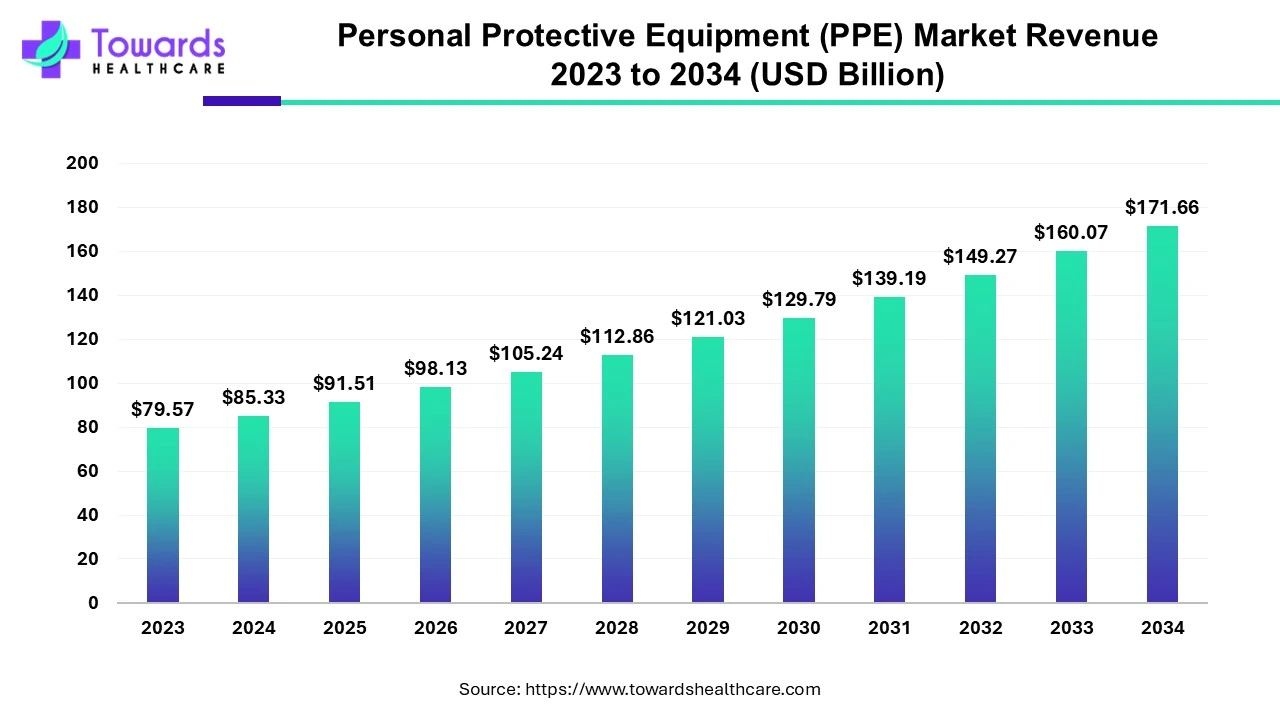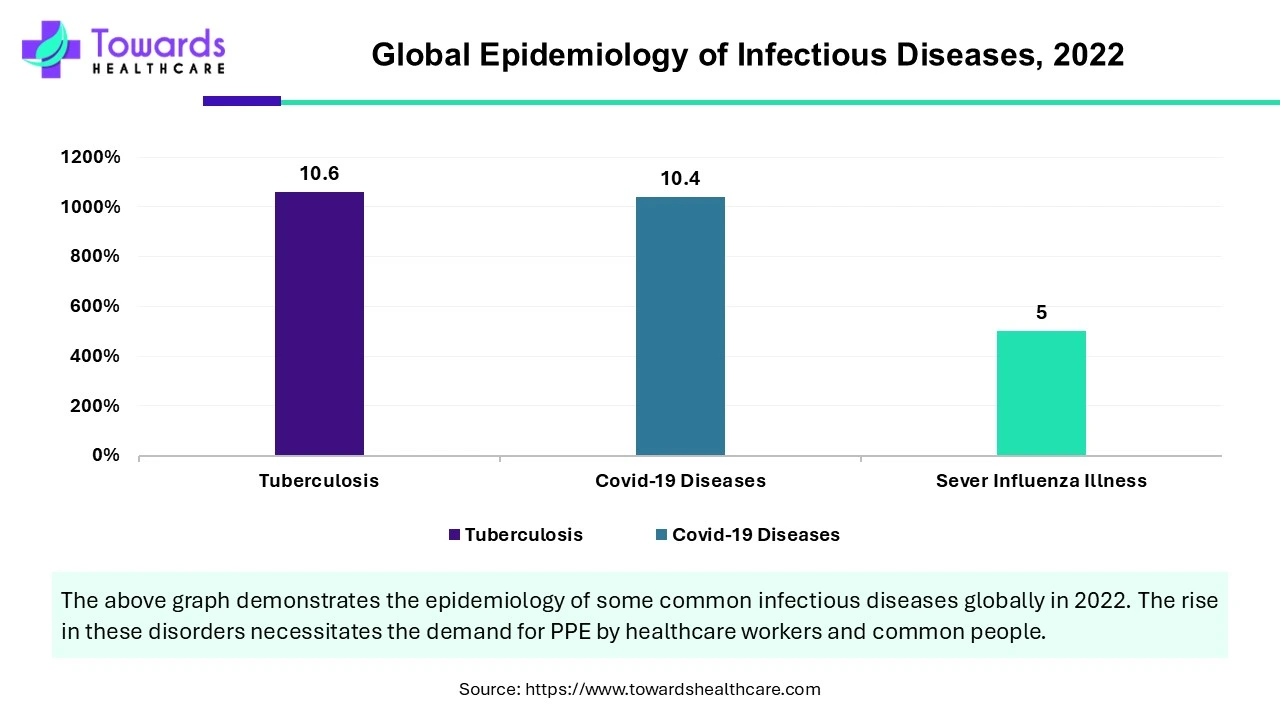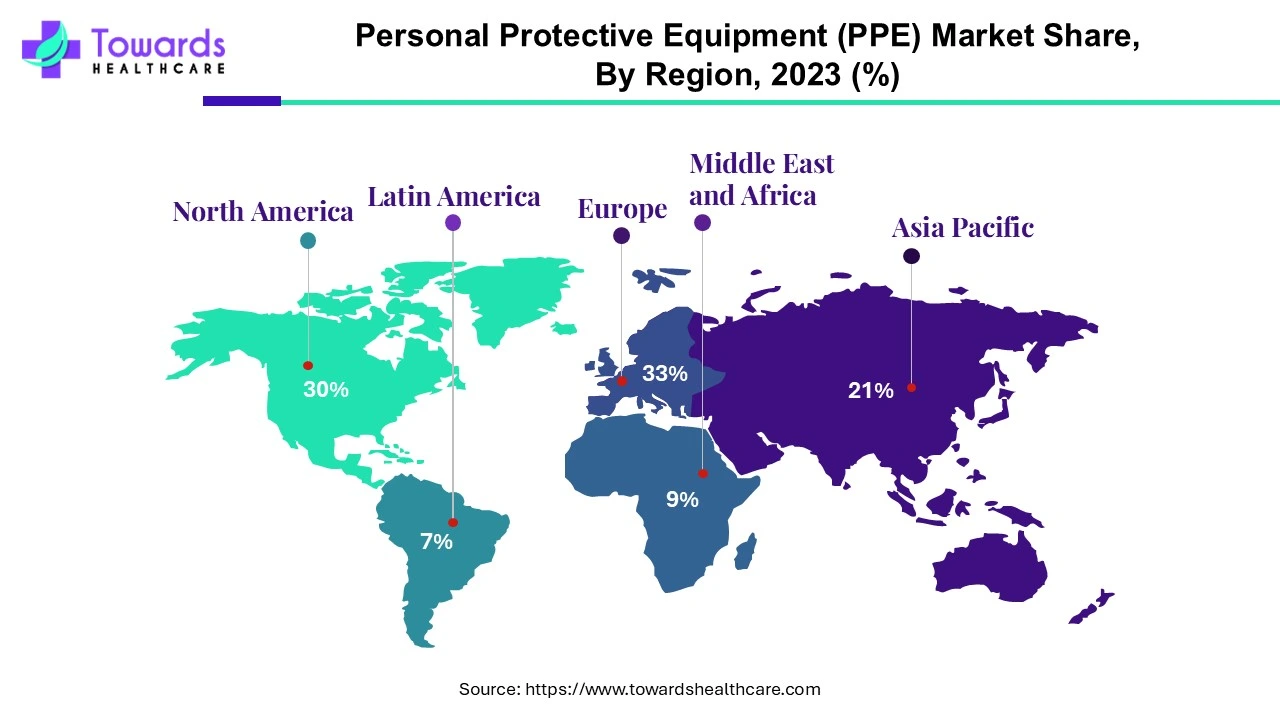November 2025

The personal protective equipment (PPE) market was estimated at US$ 79.57 billion in 2023 and is projected to grow to US$ 171.66 billion by 2034, rising at a compound annual growth rate (CAGR) of 7.24% from 2024 to 2034.

Personal protective equipment (PPE) is protective clothing worn to minimize exposure to hazards that cause serious workplace injuries and illnesses. A PPE protects a person from several biological, chemical, radiological, electrical, and mechanical hazards. PPE includes protection of eyes, head, ears, respiratory, hand, body, and foot. The most common tools of PPE include safety goggles, face shields, respirators, hard hats, headgear, safety vests and suits, safety gloves, knee pads, and safety boots. PPE is widely used by workers in pharmaceutical industries as well as healthcare workers in hospitals. PPE can mitigate transmission of biological agents through person-to-person contact, droplet spread, airborne transmission, and contaminated objects. PPEs also prioritize engineering and administrative controls to improve workplace safety and address the underlying causes of safety hazards. PPEs are generally made of raw materials such as plastics, rubber and metals.
Artificial intelligence (AI) and machine learning algorithms fundamentally alter our world and have penetrated the safety industry. Primarily, AI can be used to design novel PPEs depending on their field of application with more human-centric design features. AI can also suggest different combinations of materials for manufacturing PPE to improve strength and durability, as well as provide safety. AI can also provide a real-time vision-based safety system to detect and record potential safety breaches, promoting compliance and ultimately preventing accidents before they happen. Additionally, AI can automate the manufacturing process of PPE, producing efficient and reproducible results. Furthermore, researchers have tested the ability of AI to analyze PPE donning and doffing with real-time feedback for remediation. AI can also provide safety training to healthcare workers to improve adherence to existing safety protocols, such as real-time hand hygiene alerts in the outpatient setting using sensors.
For instance,
The incidence of communicable diseases increases whena healthy person comes in contact with an infected person. This scenario is most common in healthcare facilities such as hospitals and clinics. Several government organizations and the WHO urge the use of PPE at healthcare facilities for the safety of healthcare workers. Hospital-associated infections (HAIs) are the most common infectious disorders, accounting for more than one million cases every year in the US. PPE, such as gowns, gloves, masks, and goggles, reduce transmission of communicable diseases by providing a physical barrier to the skin. The rise in infectious diseases urges hospitals to develop strict guidelines on using PPE, as well as proper donning and doffing to avoid contamination from PPE and develop a safe workplace.

The primary and major challenge faced by the market is the disrupted supply chain. The rising demand for PPEs needs to be fulfilled by the timely supply of sufficient quantities to the local people. However, a global pandemic like COVID-19 saw a sudden rise in the demand for PPE, leading to insufficient supply. The raw materials required for manufacturing PPEs, like plastics, rubber, and metals, are also used in other sectors, resulting in their shortage. Additionally, the supply chain can be disrupted by other reasons, such as geopolitical issues that hamper the market.
The growing research & development activities in all sectors help us to find more efficient and innovative products. Hence, such activities in PPE are essential to enhance the productivity of healthcare professionals in a safer system. Some of the recent research activities for PPE are mentioned below. It has been reported that PPE should completely fit the body to provide protection. Hence, several researchers are innovating novel designs for PPEs to fit every individual irrespective of their size and weight.
In addition, novel chemical substances or raw materials are used to develop functional polymers like rubbers and fibers to enhance durability, achieve better wearer compliance, and reduce respiratory resistance. Furthermore, women working in healthcare who are exposed to radiation from X-rays and other imaging procedures tend to have a higher risk of developing breast cancer. Researchers suggest the use of additional protection, such as capped sleeves and axillary wings, that can be worn under standard gowns to reduce radiation exposure and potentially help prevent breast cancer in female healthcare workers.
The hand protection segment held a dominant presence in the personal protective equipment (PPE) market in 2023. The hand protection components include gloves and finger guards. Medical gloves protect healthcare workers or patients from the spread of infection or illnesses during medical examinations. Gloves prevent the spread of infections by touching any surface or substance, such as blood and mucous membranes, and non-intact skin, such as wounds or surgical incisions. In the healthcare sector, generally, two types of gloves are widely preferred – disposable and durable gloves. Disposable gloves are the most common choice as they can be easily discarded after use, preventing further contamination. Also, disposable gloves are cheaper alternatives and are affordable for everyone. Disposable gloves are made of latex, vinyl, nitrile, and polyethylene.
The respiratory protection segment is expected to grow at the fastest rate in the personal protective equipment (PPE) market during the forecast period. Respiratory protection or masks cover the nose and mouth, preventing penetration of any fluid or microbial substances. The two different types of masks include surgical and respirator. Surgical masks are worn by all infected persons, thereby limiting the spread of infectious particles from the infected persons into the environment. However, this mask does not protect against inhalation of small particles as it does not contain any filtering system. On the other hand, healthcare professionals wear respiratory masks to protect themselves from infections. Out of the different types of respirator masks, N95 masks are widely used in the healthcare sector. They offer filtration protection of airborne particles up to 94%.
The hospitals segment registered its dominance over the global personal protective equipment (PPE) market in 2023. PPEs are predominantly used in hospitals due to the large inflow of infected patients and the higher risk of microbial contamination. All hospital staff, patients, and visitors use PPE before contact with blood or other bodily fluids or when exposed to air-borne diseases. The common components of PPE in hospitals are surgical masks and N95 respirators, medical gloves, and medical gowns. Also, the rising incidences of hospital-associated infections (HAIs) and the COVID-19 pandemic boosts the market. Additionally, hospitals need to follow strict regulatory guidelines about the safety of healthcare professionals & patients and protect them from infections.
The home healthcare segment is anticipated to grow with the highest CAGR in the personal protective equipment (PPE) market during the studied years. Home healthcare services include a range of nursing care to specialized medical services, depending on the patient’s condition. A person can be exposed to biological and chemical hazards by inhalation, contact with the skin, ingestion, or through mucous membranes. PPEs used in home care include gloves, face shields, goggles or safety glasses, masks, and protective clothing such as disposable aprons, sleeves, or gowns. The rising geriatric population and unhealthy aging of the population augment the market. Also, the geriatric population has considerably higher chances of infections due to low immunity, necessitating the use of PPE in home healthcare.

Europe dominated the global personal protective equipment (PPE) market share by 33% in 2023. The favorable government policies and the presence of key players drive the market. The European Commission imposes stringent regulations on the design, manufacture, and marketing of PPE. It defines legal obligations to ensure that PPE on the EU internal market provides the highest level of protection against risks. The market is also driven by increasing cases of COVID-19. According to the WHO, the total number of confirmed cases in the European region was found to be approximately 277 million as of 2023. This increases the demand for PPE by healthcare professionals and patients. Additionally, the established healthcare infrastructure and increasing investments augment the market.
For instance,
Asia-Pacific is estimated to be the fastest-growing personal protective equipment (PPE) market during the forecast period. The rising geriatric population, increasing incidences of infectious diseases, and growing healthcare infrastructure drive the market. As of April 2024, India and Japan reported the highest number of COVID-19 cases, with approximately 45 million cases and 33 million cases. Hence, India has the second-highest number of confirmed cases in the world. This demands the use of PPE, thereby preventing further spread of the disease. The market in this region is also driven by the presence of key players and favorable manufacturing infrastructure. China is the leading manufacturer of PPE in the world, followed by India. Additionally, government policies and investments boost the market.
North America is expected to grow significantly in the personal protective equipment (PPE) market during the forecast period. North America is experiencing a rise in awareness about the use of PPE kits in the healthcare sector. Furthermore, the growing research where the researchers have to work in the presence of bacteria or viruses for developing new diagnostic or treatment options is also contributing to their increased demand. Furthermore, the government, as well as the regulatory bodies, are also supporting their use by providing investments as well as guidelines for their proper use.
The industries in the U.S., as well as the hospital, are increasing their demand for the use of PPE kits. The growing awareness to enhance the safety in the presence of any infectious agents or from injuries is leading to a growth in their use. Furthermore, the government is supporting the healthcare sector by providing investments.
The increasing research in the biotechnological or pharmaceutical industries is increasing the demand for PPE kits. Furthermore, to ensure the proper use and disposal of these kits, regulatory bodies are also providing guidelines. Thus, all these factors enhance the market growth.
Latin America is expected to grow significantly in the personal protective equipment (PPE) market during the forecast period. The industries in Latin America are advancing, which in turn are increasing the demand for PPE to protect the professionals from various factors. The increasing research and development for innovating new diagnostics and treatment approaches for growing infectious diseases is increasing their use. Moreover, due to their growing use in hospitals and industries, the government is providing investments and promoting their use. Thus, all these advancements are enhancing the market growth.
The Middle East and Africa are expected to show lucrative growth in the personal protective equipment (PPE) market during the forecast period. The Middle East and Africa are experiencing a rise in infectious diseases. This, in turn, is increasing the demand for PPE. At the same time, the increasing awareness is also contributing to the same. Moreover, the expanding hospitals, clinics, and labs, as well as growing emergency situations, are increasing their use. Thus, all these developments are promoting the market growth.
In September 2024, the Chairman and Co-CEO of AirBoss, Gren Schoch, stated that for the delivery of critical needs, they are now in a situation of collaborating with HHS due to their track record in critical medical equipment and supplies, which were provided during the most challenging of times. Moreover, to provide protection from communicable diseases as well as CBRNE threats to the healthcare workers, military personnel, and first responders, they have already demonstrated their strength as a domestic provider of personal protective equipment (“PPE”).
| Company Name | Ansell Ltd. |
| Headquarters | Richmond, Australia |
| Recent Development | In April 2024, Ansell, an Australian company, announced the acquisition of Kimberly-Clark’s PPE business for $640 million. The acquisition will improve Ansell’s market position through Kimberly-Clark’s PPE business designs and market gloves, safety eyewear, and protective apparel to healthcare and industrial companies. |
| Company Name | Medicom Group, Inc. |
| Headquarters | Montreal, Canada |
| Recent Development |
In December 2023, Ontario secured a stable and reliable domestic source of medical-grade nitrile gloves through Medicom Group Inc.’s $165 million investment to construct a new 140,000-square-foot production facility in London. The new plant will maintain a robust stockpile of PPE to safeguard healthcare, hospitals, and frontline workers across the province. |
By Product
By End-Use
By Region
November 2025
November 2025
December 2025
November 2025